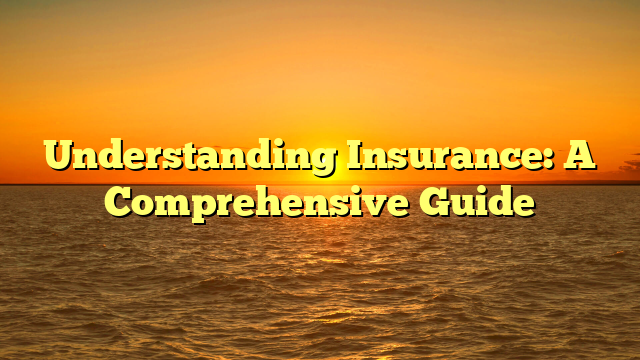Insurance is a fundamental aspect of modern life, providing individuals, businesses, and organizations with financial protection against unforeseen events and risks. From health and auto insurance to life and property coverage, the insurance industry plays a vital role in safeguarding assets and providing peace of mind. In this comprehensive guide, we delve into the intricacies of insurance, exploring its various types, key concepts, and important considerations.
What is Insurance?
At its core, insurance is a contract between an individual or entity (the insured) and an insurance company (the insurer), wherein the insured pays a premium in exchange for financial protection against specified risks. In the event of a covered loss or occurrence, the insurer agrees to compensate the insured according to the terms of the policy.
Types of Insurance
1. Health Insurance
Health insurance provides coverage for medical expenses incurred due to illness, injury, or preventive care. It helps individuals afford healthcare services, including doctor visits, hospital stays, prescription medications, and medical procedures.
2. Auto Insurance
Auto insurance protects vehicle owners against financial losses resulting from accidents, theft, or damage to their vehicles. It typically covers liability for bodily injury or property damage caused to others, as well as collision and comprehensive coverage for the insured’s vehicle.
3. Life Insurance
Life insurance provides financial protection to beneficiaries in the event of the insured’s death. It helps replace lost income, cover funeral expenses, pay off debts, and provide for dependents after the insured’s passing. Types of life insurance include term life, whole life, and universal life policies.
4. Property Insurance
Property insurance safeguards real estate and personal belongings against damage or loss caused by perils such as fire, theft, vandalism, or natural disasters. It includes homeowners insurance, renters insurance, and commercial property insurance.
5. Liability Insurance
Liability insurance protects individuals and businesses from legal claims and financial liabilities arising from injuries or property damage caused to others. It covers legal defense costs, settlement payments, and court-ordered judgments.
Key Concepts
1. Premium
The premium is the amount paid by the insured to the insurer in exchange for coverage. It may be paid annually, semi-annually, quarterly, or monthly, depending on the terms of the policy.
2. Deductible
The deductible is the out-of-pocket amount that the insured must pay before the insurance coverage kicks in. A higher deductible typically results in lower premiums, while a lower deductible leads to higher premiums.
3. Coverage Limits
Coverage limits specify the maximum amount that an insurer will pay for covered losses or claims. It’s essential for insured individuals to understand their policy’s coverage limits to ensure adequate protection.
4. Exclusions
Exclusions are specific perils or circumstances that are not covered by an insurance policy. It’s crucial for policyholders to review their policy documents carefully to understand what is and isn’t covered.
Important Considerations
1. Assessing Needs
Before purchasing insurance, individuals should assess their needs and risks to determine the types and amounts of coverage required. Factors such as age, health, financial status, and lifestyle can influence insurance needs.
2. Comparing Policies
It’s advisable to shop around and compare insurance policies from different providers to find the best coverage options at competitive rates. Online tools and resources can help individuals compare quotes and coverage details easily.
3. Reviewing Regularly
Insurance needs can change over time due to life events such as marriage, birth of children, home purchase, or career changes. It’s essential to review insurance policies regularly and make necessary adjustments to ensure adequate coverage.
4. Understanding Terms
Insurance contracts can be complex, with various terms, conditions, and exclusions. Individuals should take the time to read and understand their policy documents thoroughly, seeking clarification from their insurance agent or provider as needed.
Conclusion
In conclusion, insurance is a vital financial tool that provides protection and security in an uncertain world. By understanding the different types of insurance, key concepts, and important considerations, individuals can make informed decisions to safeguard their assets and loved ones effectively. Whether it’s protecting against health-related expenses, auto accidents, property damage, or liability claims, insurance offers peace of mind and financial stability in times of need.
